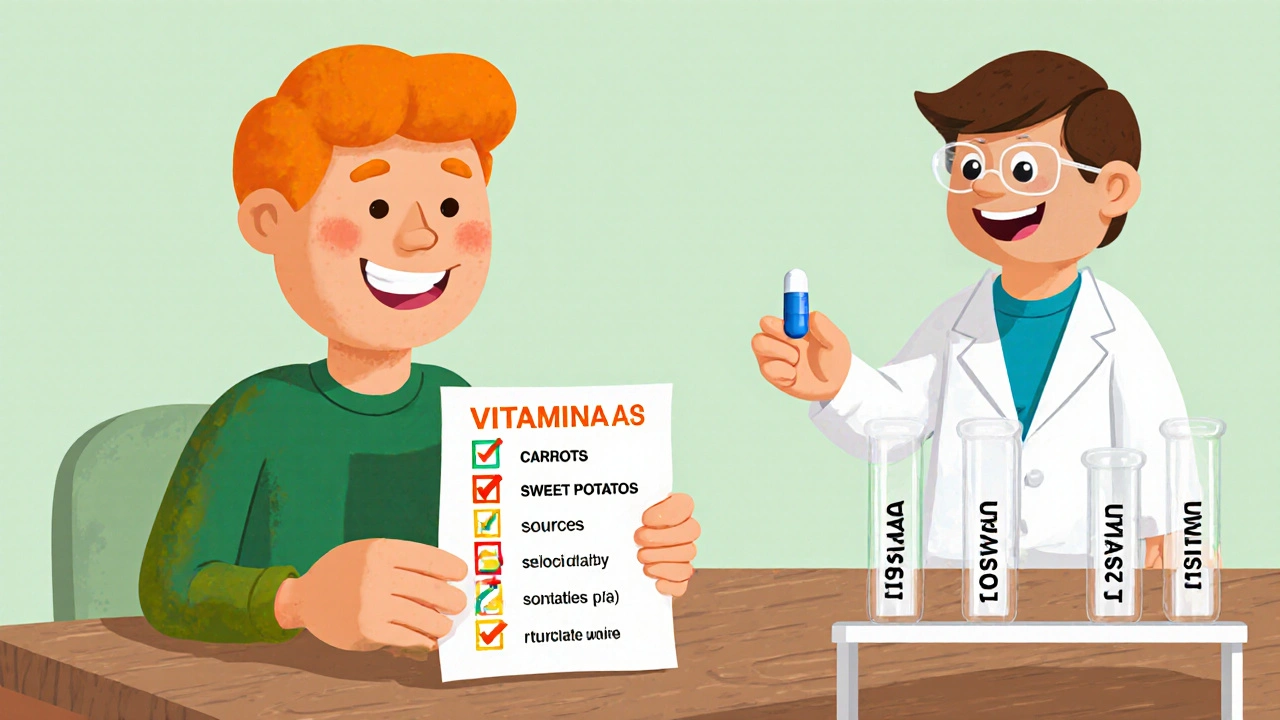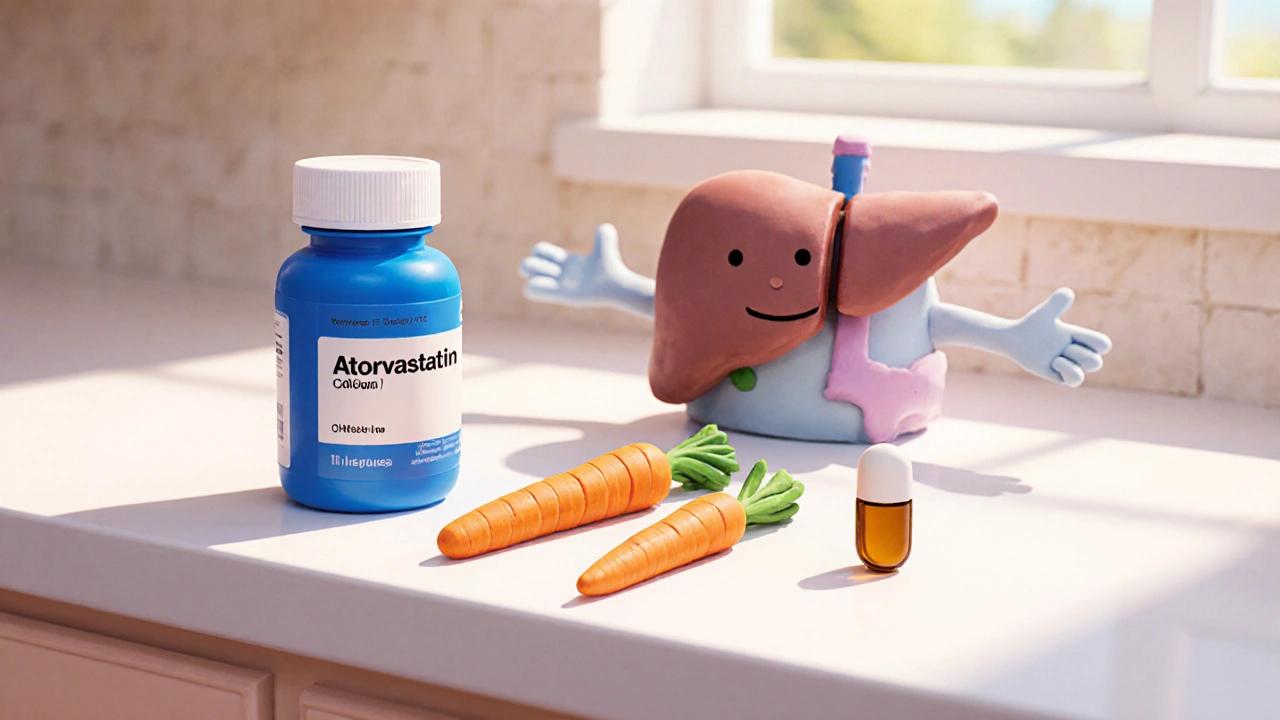If you’ve been prescribed Atorvastatin - a cholesterol‑lowering pill that belongs to the statin family - and you’re also considering a vitamin A supplement, you probably wonder whether the two play nicely together. The short answer: most people can take them side‑by‑side, but a few nuances matter. Below we break down what each does, where they can overlap, and how to keep your liver, muscles, and eyesight happy.
Key Takeaways
- Atorvastatin lowers LDL‑cholesterol by blocking HMG‑CoA reductase; vitamin A supports vision and immune health.
- There’s no direct chemical clash, but high‑dose vitamin A can stress the liver - the same organ that processes atorvastatin.
- Stick to the Recommended Daily Allowance (RDA) for vitamin A (900 µg retinol activity equivalents for adult men, 700 µg for adult women) unless a doctor says otherwise.
- Watch for muscle pain, unexplained fatigue, or yellow‑tinted skin; these could signal a rare interaction.
- Regular blood tests for liver enzymes (ALT, AST) help catch problems early.
Understanding Atorvastatin
Atorvastatin is a statin that works by inhibiting the enzyme HMG‑CoA reductase, the rate‑limiting step in cholesterol synthesis. By reducing the production of LDL‑cholesterol, it lowers the risk of heart attack and stroke. Typical doses range from 10 mg to 80 mg once daily, and the drug is metabolized primarily in the liver by the CYP3A4 pathway. Because the liver is the central processing hub, any other substance that also taxes liver function warrants a closer look.
What Vitamin A Does
Vitamin A refers to a family of compounds that include retinol, retinal, and provitamin A carotenoids (like beta‑carotene). In the body, it’s essential for night vision, skin integrity, and immune defense. Dietary sources span leafy greens, orange vegetables, liver, and fortified dairy. The RDA for adults is 900 µg RE for men and 700 µg RE for women, while the tolerable upper intake level (UL) sits at 3,000 µg RE per day. Exceeding the UL for prolonged periods can lead to toxicity, manifesting as liver enlargement, joint pain, and even hair loss.
How the Two Interact
There’s no known pharmacokinetic clash - meaning atorvastatin doesn’t alter how vitamin A is absorbed, nor does vitamin A change the statin’s blood levels. The main overlap is physiological: both rely on the liver for processing. Taking high‑dose vitamin A (often found in mega‑dose supplements or liver‑based cod‑liver oil) adds extra work for hepatic enzymes, potentially raising ALT and AST levels that your doctor monitors while you’re on a statin.
Atorvastatin vitamin A interaction becomes a concern primarily when vitamin A intake exceeds the UL or when a patient already has borderline liver function. In such cases, the liver may struggle to clear both substances, increasing the risk of liver‑related side effects.
| Age Group | RDA (µg RE) | UL (µg RE) | Notes for Statin Users |
|---|---|---|---|
| Adults 19‑70 | 900 (men) / 700 (women) | 3,000 | Stay ≤ RDA; avoid > 2,500 µg without medical supervision. |
| Pregnant women | 770 | 2,800 | Excess vitamin A linked to birth defects; keep well below UL. |
| Seniors > 70 | 800 | 2,800 | Liver reserves decline; monitor enzymes every 3‑6 months. |
Practical Guidance for Patients
- Check Your Current Vitamin A Sources. List foods, multivitamins, and any dedicated eye‑health supplements you take.
- Calculate Total Daily Intake. Use the numbers on supplement labels (often in IU; 1 µg RE ≈ 3.33 IU) to ensure you stay under the UL.
- Ask Your Doctor About Liver Monitoring. If you’re on a high dose of atorvastatin (≥ 40 mg) or have a history of liver disease, request baseline ALT/AST labs and follow‑up testing.
- Watch for Warning Signs. Muscle aches, dark urine, yellow skin, or persistent fatigue merit a call to your healthcare provider.
- Prefer Food‑Based Vitamin A. Beta‑carotene from carrots or sweet potatoes converts to retinol only as needed, lowering toxicity risk.

Monitoring and When to Seek Help
Most clinicians order a liver‑function panel before starting a statin and repeat it after 6-12 weeks. If you add a vitamin A supplement that pushes you close to the UL, ask for an extra check. Typical thresholds that trigger a follow‑up:
- ALT or AST rising > 3× the upper normal limit.
- New onset muscle pain with CK (creatine kinase) elevation.
- Skin changes (yellowing) or unexplained nausea.
Promptly report any of these symptoms; adjusting the statin dose or switching to a different lipid‑lowering agent can resolve the issue.
Frequently Asked Questions
Can I take a multivitamin that contains vitamin A while on atorvastatin?
Yes, as long as the multivitamin provides no more than the RDA for your sex and age. Most over‑the‑counter multivitamins stay well below the UL, making them safe with atorvastatin.
Do I need to stop vitamin A supplements if I experience mild liver enzyme elevation?
Your doctor will likely advise pausing the supplement until repeat labs normalize. The goal is to reduce any additional liver load while investigating the cause.
Is beta‑carotene safer than preformed vitamin A for statin users?
Beta‑carotene is converted to retinol only as needed, so it carries a lower risk of toxicity. It’s a good choice if you need extra eye support while on a statin.
Can atorvastatin cause vitamin A deficiency?
No. Atorvastatin does not affect the absorption or metabolism of vitamin A, so deficiency is unlikely unless dietary intake is very low.
What liver tests should I ask for while on both atorvastatin and vitamin A?
ALT (alanine aminotransferase) and AST (aspartate aminotransferase) are standard. Some clinicians also check GGT (gamma‑glutamyl transferase) if you have a history of alcohol use.
Next Steps
Start by reviewing the labels of any vitamin A‑containing products you use. If the total daily amount creeps toward the UL, talk to your prescriber about either lowering the dose or swapping for a beta‑carotene‑rich food source. Keep an eye on your lab results, and don’t ignore muscle or skin changes. With a bit of mindfulness, atorvastatin and vitamin A can coexist safely, letting you protect both your heart and your vision.


Greg Galivan
October 25, 2025 AT 18:03If you think you can just pop a mega dose of vitamin A with your statin, think agian. The liver’s already busy breaking down atorvastatin, so adding high‑dose retinol is a recipe for trouble. Keep it under the RDA or you’ll be dealing with elevated enzymes.
christine badilla
October 25, 2025 AT 19:33Oh my gosh, I was literally shaking when I read about that liver warning! My heart was pounding like a drum, but then I remembered beta‑carotene saves the day. Sooooo, stick to food sources and breathe easy!
Octavia Clahar
October 25, 2025 AT 21:13Honestly, most folks overlook the simple math: RDA of vitamin A plus a statin isn’t a clash if you track the numbers. Just tally up your supplement label, stay below 2,500 µg RE if you’re on a high dose atorvastatin, and you’ll be fine. Keep the labs in check and you’ll avoid the drama.
eko lennon
October 25, 2025 AT 23:43When you pop Atorvastatin every morning, you’re already asking your liver to do a heavy lift. Now imagine tossing a high‑dose vitamin A supplement into that same mix. The liver doesn’t care about your good intentions; it just processes chemicals. Each extra gram of retinol adds to the enzymatic workload, and the cytochrome system can get overwhelmed. That’s why clinicians whisper about monitoring ALT and AST levels. If those enzymes start climbing, it’s a red flag that the organ is under stress. Muscle aches can follow, because statins already have a notorious side effect profile. You don’t want to confuse a statin‑induced myalgia with a vitamin A‑induced toxicity. A safe strategy is to keep vitamin A intake at or below the Recommended Daily Allowance unless your doctor says otherwise. Beta‑carotene from carrots converts only as needed, acting like a built‑in safety valve. If you’re chasing a mega‑dose for eye health, reconsider; the marginal benefit rarely outweighs the hepatic risk. Regular labs every three to six months can catch a problem before it becomes serious. Talk to your prescriber about the exact dose you’re taking; sometimes a simple label read‑through saves weeks of trouble. Remember that the UL for vitamin A sits at 3,000 µg RE, but for statin users a lower ceiling is prudent. In practice, many physicians suggest staying under 2,500 µg RE if you’re on a high‑intensity statin. Bottom line: respect the liver’s capacity, balance your supplements, and you’ll keep both heart and sight in good shape.
Sunita Basnet
October 26, 2025 AT 01:06Leveraging hepatic clearance pathways synergistically optimizes pharmacokinetic profiles while mitigating enzymatic overload consider aligning vitamin A RE intake with statin metabolic fluxes avoid surpassing the tolerable upper intake level maintain ALT/AST baselines for proactive therapeutic monitoring
Melody Barton
October 26, 2025 AT 03:20Listen, the liver can only handle so much so if you’re on a high dose of Atorvastatin cut the vitamin A back to the RDA don’t be a hero and risk liver injury you’ve got this stay disciplined and keep those labs clean
Justin Scherer
October 26, 2025 AT 05:16Just a heads‑up that checking your supplement label and talking to your doctor about liver tests is a solid move it’s easy to stay on top of both cholesterol and eye health without overloading the system
Pamela Clark
October 26, 2025 AT 07:13Wow, another post telling us not to be reckless with vitamins… groundbreaking stuff. I guess next we’ll learn that water is wet and the sky is blue. Thanks for the riveting reminder.
Diane Holding
October 26, 2025 AT 09:26Stay under the RDA and get regular liver panels.